The global solar boat market was valued at $0.65 billion in 2021, and is projected to reach $2.4 billion by 2031, growing at a CAGR of 14.2% from 2022 to 2031.
Solar boat or solar electric boats are marine vessels, which are operated with battery power and has solar panels for charging the battery. Solar boats utilize solar energy to power the boats’ motors, navigation systems, and onboard electronic equipment. Solar panels mounted on the boat harvest solar energy from the sun and transfer it to a charge controller, which controls flow of electricity to rechargeable batteries, such as lithium-ion batteries. In addition, solar boats have several advantages, such as lower running costs, less maintenance, less environmental impact, and others.
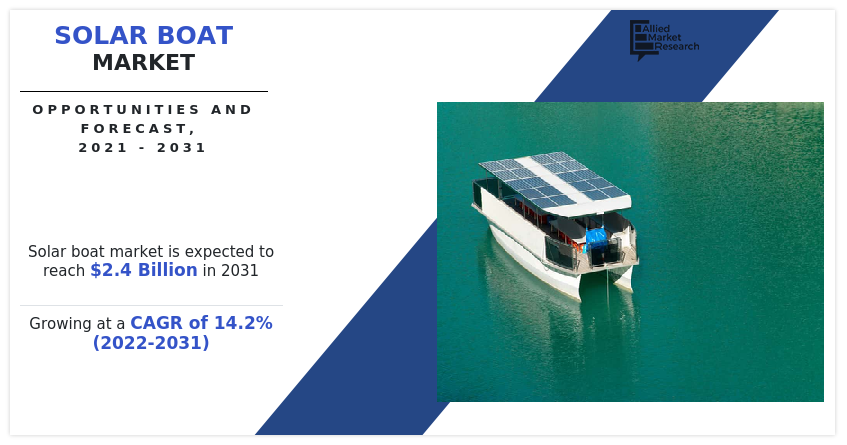
The growth of the global solar boat market is propelling due to introduction of stringent emission regulations, and growth in the marine tourism industry across the globe. However, less operational efficiency and high purchase and maintenance cost of solar boats are factors hampering the growth of the market. Furthermore, government support to promote adoption of electric and solar boat is expected to offer growth opportunities during the forecast period.
The solar boat market is segmented on the basis of battery type, solar panel type, application, and region. By battery type, it is classified into lead acid, lithium-ion, and others. By solar panel type, it is categorized into monocrystalline and polycrystalline. By application, it is fragmented into passenger boats, cargo boats, and others. By region, the report is analyzed across North America, Europe, Asia-Pacific, and LAMEA.
Some leading companies profiled in the solar boat market report comprises ABB Ltd., Aquawatt (Aquawatt Green Marine Technologies), Boesch Motorboote AG, Corvus Energy, Duffy Electric Boat Company, ElectraCraft, Inc., Greenline Yachts, Grove Boats SA, NavAlt Solar & Electric Boats Pvt. Ltd., Quadrofoil d.o.o., RAND Boats ApS, Soel Yachts B.V., Torqeedo GmbH, and Vision Marine Technologies Inc.
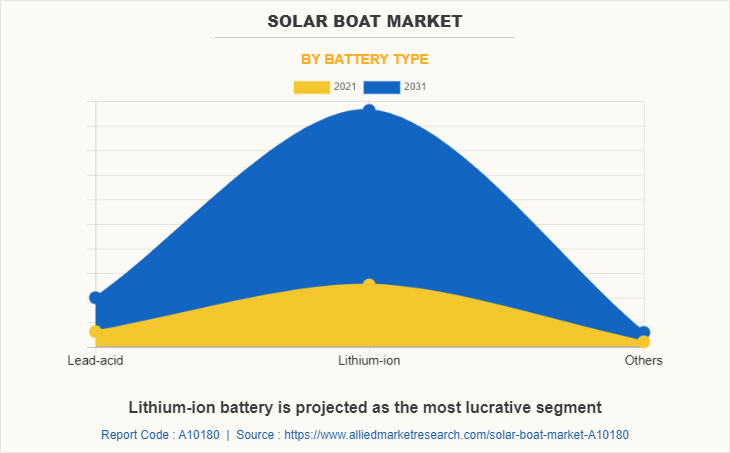
Introduction of stringent emission regulations
Electric and solar electric boats are increasingly replacing fuel powered boats, owing to stringent government norms for controlling carbon emissions and growing environmental concerns. Traditional or conventional boats produce a large amount of exhaust gases, including nitrogen oxide, sulfur oxide, and CO2. With cargo ships being one of the highest sources of pollution in seaports, there has been a greater emphasis on reducing emissions from boats and ships.
In addition, organizations such as International Maritime Organization (IMO) have implemented numerous regulations to cut down emissions, which, in turn, boosts adoption of electric and solar electric boats during the forecast period. Moreover, electric and solar electric boats run on clean energy and offer several features, such as noiseless engine, and cheaper & less maintenance, which contribute toward adoption of electric and solar electric boats. Thus, rise in adoption of electric and solar electric boats, owing to environmental concerns and stringent emission regulations drives the growth of the solar boat market
Growth in marine tourism industry globally
Maritime tourism refers to sea-based tourist activities, including boating, cruising, yachting, and nautical sports. In recent years, maritime tourism has gained traction across the globe. As per a review undertaken by the World Economic Forum, maritime and coastal tourism is expected to grow at a global rate of 3.5% by 2030.
In addition, several governments have taken initiatives to promote maritime travel & tourism activities. For instance, in 2021, the government of India planned to develop 78 maritime tourism landmarks across India to enhance development of existing lighthouses and its surrounding areas into unique maritime tourism landmarks.
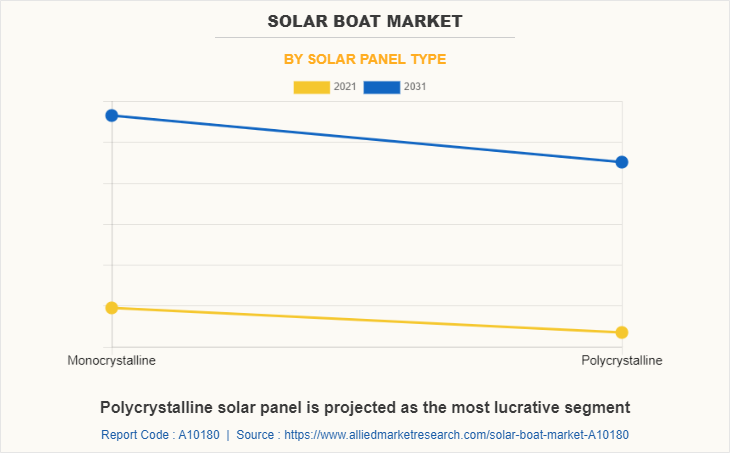
Moreover, maritime tourism activities require yachts, ferries, and cruise ships. Generally, these ships or vessels run on traditional fossil fuel-based engines, which emit harmful pollutants, such as nitrogen oxide, sulphur oxide, and CO2. However, boat manufacturers have started to introduce electric and solar electric boats and ships to support marine tourism activities as well as to reduce carbon footprints and pollution, which supplements the growth of the market. For instance, in 2022, Candela unveiled P-8 Voyager electric boat. The boat is designed to be a long-range water taxi to be used for tourism. It has a range of 40 nautical miles at a speed of 22 knots. Hence, the growing marine tourism industry across the globe is anticipated to drive the growth of the solar boat market during the forecast period.
Less operational efficiency
Solar boats have lower efficiency as compared to the internal combustion engine-based boats. This is attributed to fact that solar boats are equipped with batteries, which are required to propel the vehicle. However, these batteries have a limited range to operate, which restrain their adoption. In addition, although solar boats are effective during favorable weather conditions, they do not operate effectively in extreme weather conditions, such as during heavy rainfall or snowfall, which hampers the sale of solar boats, thereby restraining the growth of the global solar boat market. Hence, less operational efficiency of solar boats negatively impacts the overall growth of the market.
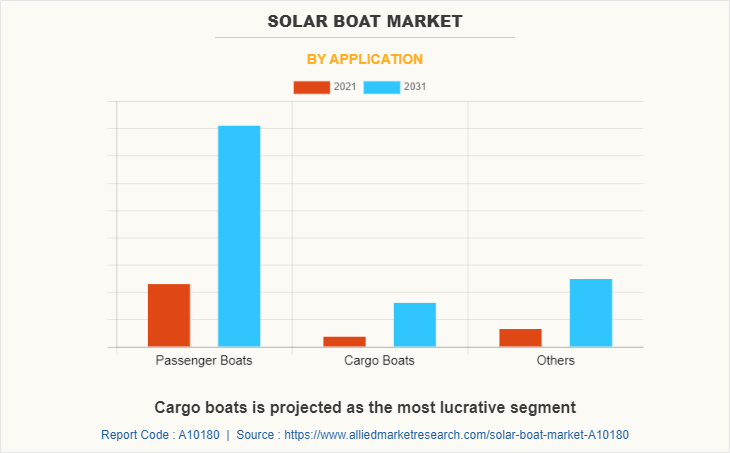
High purchase and maintenance cost of solar boats
High cost of solar boats is a major factor that restrains the growth of the solar boat market. The cost of the battery and technology makes solar boats costlier as compared to traditional or conventional boats. Hence, consumers find conventional boats superior in performance with same or less price. Moreover, the use of solar panels used in the boats incurs the maximum cost, thereby restraining the growth of the market. Furthermore, charging and maintenance of the battery is one of the major concerns for the adoption of solar boats. High battery pack replacement cost, owing to short life of the batteries and high electric component maintenance cost, increases the overall maintenance cost of these boats. Hence, upsurge in the adoption of solar boats in other than developed countries such as China and the U.S., is limited by high costs. Therefore, high maintenance and purchase cost is a major factor that restrains the growth of the market.
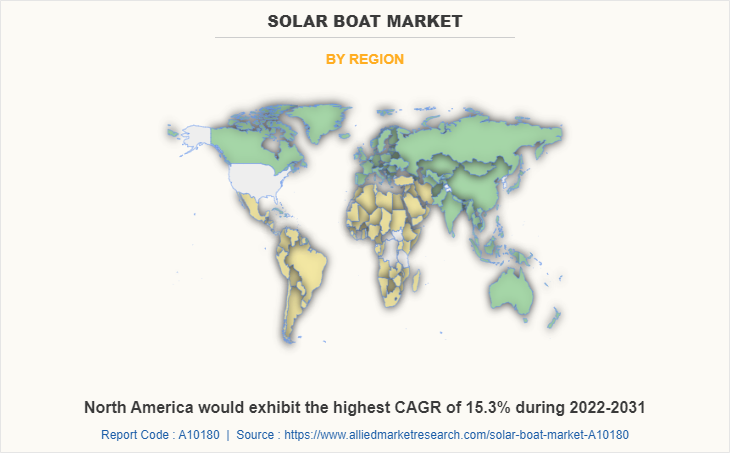
The solar boat market is segmented into Battery Type, Solar Panel Type and Application.
Key Benefits For Stakeholders
- This report provides a quantitative analysis of the market segments, current trends, estimations, and dynamics of the solar boat market analysis from 2021 to 2031 to identify the prevailing solar boat market opportunities.
- The market research is offered along with information related to key drivers, restraints, and opportunities.
- Porter's five forces analysis highlights the potency of buyers and suppliers to enable stakeholders make profit-oriented business decisions and strengthen their supplier-buyer network.
- In-depth analysis of the solar boat market segmentation assists to determine the prevailing market opportunities.
- Major countries in each region are mapped according to their revenue contribution to the global market.
- Market player positioning facilitates benchmarking and provides a clear understanding of the present position of the market players.
- The report includes the analysis of the regional as well as global solar boat market trends, key players, market segments, application areas, and market growth strategies.
Solar Boat Market Report Highlights
| Aspects | Details |
| By Battery Type |
|
| By Solar Panel Type |
|
| By Application |
|
| By Region |
|
| Key Market Players | Soel Yachts B.V., ElectraCraft, RAND Boats ApS, Torqeedo GmbH, Duffy Electric Boat Company, Boesch Motorboote AG, NavAlt boats, Grove Boats SA, Quadrofoil d.o.o., Corvus Energy, Vision Marine Technologies Inc., Greenline Yachts, Aquawatt Green Marine Technologies, ABB LTD |
Analyst Review
The solar boat market is propelling due to introduction of stringent emission regulations and growth in marine tourism industry across the globe.
Several governments are focusing on reducing carbon emissions from the shipping industry. The shipping industry utilizes fossil fuel-based engines in ships or boats, which produces harmful emission from the vessels. Governments across the globe are taking several initiatives to reduce these emissions and to promote adoption of electric and solar boats. For instance, in 2019, as per the report by Norwegian Ministry of Climate and Environment, the Norway government is focusing on reducing greenhouse gas emissions from domestic shipping and fishing ships by half by 2030 and promoting development of zero and low emission solutions for all vessel categories. The government of Norway allocated $0.77 million to Green Shipping Program in the 2019 budget. In addition, in April 2022, in British Columbia, Gregory C. Marshall Naval Architect, Ltd., received nearly $1 million from a provincial government zero-emission vehicle initiative for its work developing an electric catamaran. Gregory C. Marshall Naval Architect, Ltd., received funding from the CleanBC Go Electric Advanced Research and Commercialization program to develop a low-weight, 40-foot electric utility catamaran. Government initiatives to promote adoption of electric and solar boat are expected to create growth opportunities for the market.
The global solar boat market was valued at $658.0 million in 2021 and is projected to reach $2,433.2 million in 2031, registering a CAGR of 14.2%.
The leading application is passenger boats.
The largest regional market is Europe.
The leading companies in the market include ABB Ltd., Aquawatt (Aquawatt Green Marine Technologies), Boesch Motorboote AG, Corvus Energy, Duffy Electric Boat Company, ElectraCraft, Inc., Greenline Yachts, Grove Boats SA, NavAlt Solar & Electric Boats Pvt. Ltd., Quadrofoil d.o.o., RAND Boats ApS, Soel Yachts B.V., Torqeedo GmbH, and Vision Marine Technologies Inc.
The upcoming trends in the solar boat market include greater adoption in tourism activities and development of boats with higher range.
Loading Table Of Content...



